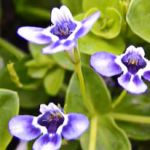| Common Name: |
Chinese Lobelia |
| Botanical Name: |
Lobelia chinensis syn. L. radicans |
| Genus: |
Lobelia |
| Family: |
Campanulaceae |
| Native Location: |
E Asia |
| Cultivation: |
Rich, moist soil in sun or partial shade. Lobelia inflata prefers slightly acid soil. |
| Propagation: |
By division in spring (perennials); by seed sown at 13-18°C (55-64°F); annuals in late winter, perennials as soon as ripe. |
| Harvest: |
Whole plants are cut when flowering. (L. inflata when lower fruits are ripe); used fresh or dried in decoctions (L. chinensis), infusions, liquid extracts, and tinctures. |
| Warning: |
Harmful if eater. Skin irritant and allergen. |
| Height: |
20cm (8in) |
| Width: |
Indefinite |
| Hardiness: |
Z5-9 |
| Parts Used: |
Whole plant (ban bian lian) |
| Properties: |
An acrid, anti-fungal herb that is diuretic, reduces inflammation, lowers fevers, contracts tissues, and clears toxins. It acts mainly on the liver and kidneys. |
| Medicinal Uses: |
Internally for dysentery, gastroenteritis, cirrhosis, edema, jaundice, schistosomiasis, stomach cancer, eczema, and snakebite with depressed respiration. Excess causes nausea, vomiting, drowsiness, and respiratory failure. For use by qualified practioners only. |
| Bibliography: |
Encyclopedia of Herbs by Deni Brown Copyright © 1995, 2001 Dorling Kindersley Limited. Pg 265 |

